- A chronic autoimmune disease;
- Identified by increased blood glucose levels;
- Caused by the insulin deficiency that occurs as the consequence of the loss of the pancreatic islet β-cells.
- The most common form of diabetes in children.
- Has a strong genetic component.
Type 1 diabetes mellitus (T1DM) is a chronic autoimmune disease that has an active genetic component, which is identified by increased blood glucose levels, also known as hyperglycemia. This type of diabetes is most common around kids and adolescents. It is caused by the insulin deficiency that occurs as the consequence of the loss of the pancreatic islet β-cells (Katsarou, et al., 2017).
Therefore, type 1 diabetes mellitus characterizes in the destruction of Langerhans cells and extreme lack of insulin in the body, which results in its inability to control blood sugar levels, that leads to the diagnosis of Type 1 diabetes mellitus.
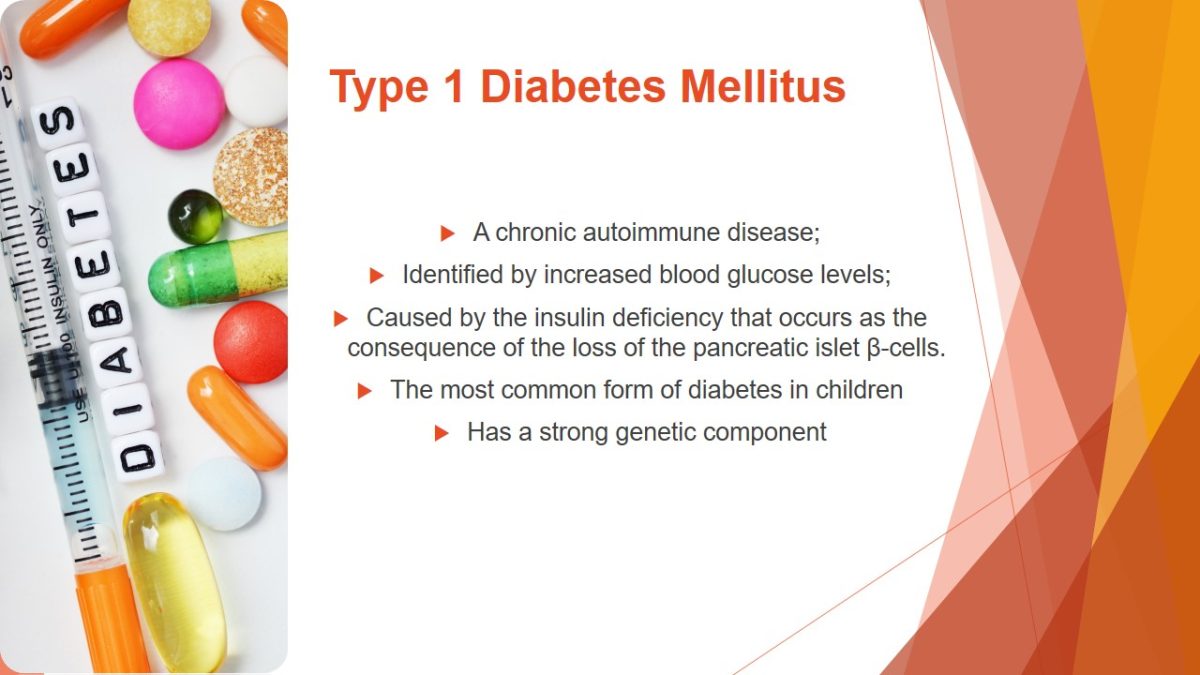
Pathogenesis
The pathogenesis of type 1 diabetes mellitus is believed to be a process that can be divided into different phases that lead to the detection of autoantibodies and progress to βcell destruction, dysglycaemia (Katsarou, et al., 2017).
Factors that trigger autoimmune response against the β-cells:
- Environmental.
- Genetic.
The pathogenesis of type 1 diabetes mellitus is believed to be a process that can be divided into different phases that lead to the detection of autoantibodies and progress to β-cell destruction, dysglycaemia (Katsarou, et al., 2017).
The one thing that scientists are sure about is the etiology of βcell-targeted autoimmunity. It most likely consists of a range of factors such as genetic and environmental, which trigger or permit the autoimmune response against the β-cells. Such actions usually occur much earlier than the disease itself.
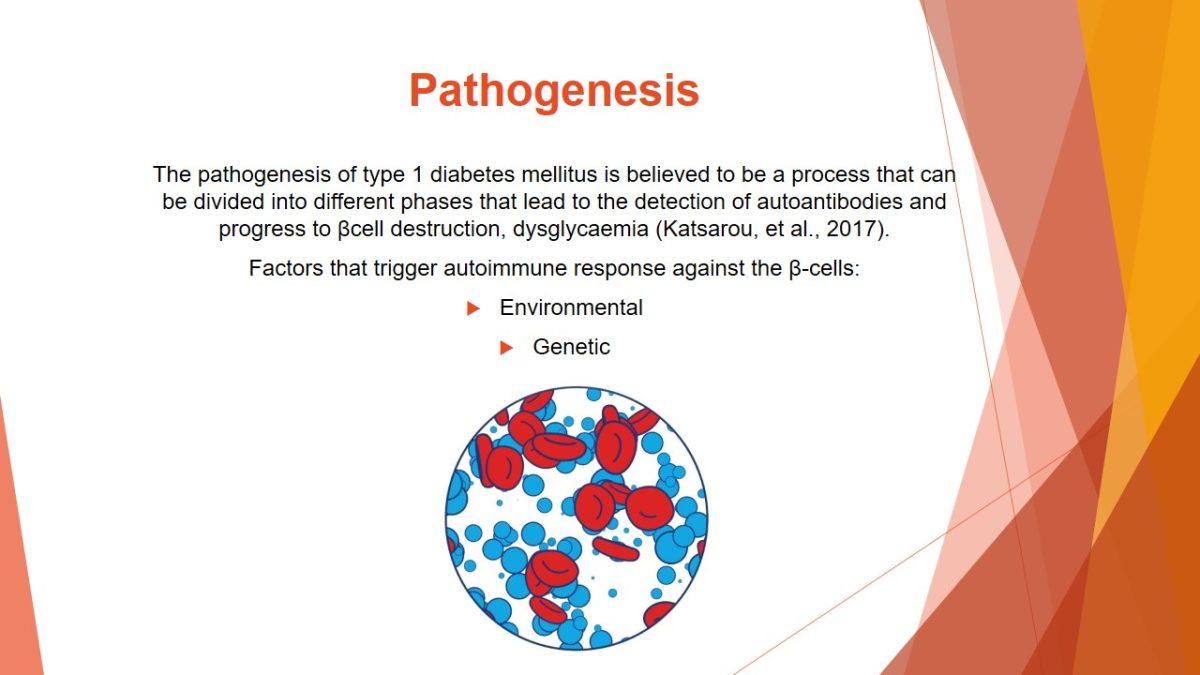
Epidemiology
25 million people in the United States have Diabetes.
Each year nearly 90 000 children are being diagnosed with this disease.
Factors that cause T1DM:
- Immune system failure (body’s immune system damages the insulin-producing cells in the pancreas).
- Demographic factor (the highest rate of type 1 Diabetes is in Europe, however it is a rare disease in Asia).
- Gender factor (girls get diagnosed with Type 1 diabetes in an earlier age rather than boys).
Each year the incidents of the one diabetes are increasing. Nearly 90 000 children are being diagnosed with this disease every year. The World Health Organization reported in 2011 that almost 350 million people had diabetes, with 25 million in the United States alone (McConnell, 2013 p. 394).
The main cause of type 1 diabetes mellitus remains unknown, however, in many cases, the body’s immune system instead of destroying harmful viruses damages the insulin-producing cells in the pancreas.
The demographic factor plays a significant role when it comes to type 1 diabetes. The rates in different countries can significantly vary. The highest rate holds Scandinavian countries, followed by European countries (primarily, the United Kingdom), North America, and Australia. In Asian countries — such as China, Korea, and Japan — T1DM is a rare disease (Katsarou, et al. 2017).
The main reason for such contrast between countries is simply the genetic susceptibility as well as environmental and lifestyle factors, possibly including hygiene and childhood infections.
Gender factor. Because type 1 diabetes mellitus is usually diagnosed in children, it has been observed that girls get diagnosed with Type 1 diabetes in an earlier age rather than boys. It is explained by the fact that the incidence increase with age and height during puberty, which girls reach earlier. However, after the puberty phase, the rates of illness significantly drop among women, but men are put at a higher risk of getting type 1 diabetes up until 35 years of age.

Signs and symptoms
Initial Symptoms:
- Increased urination.
- Extreme thirst.
- Weight Loss.
- Nausea.
- Confusion.
- Weakness.
Chronic Symptoms:
- Eye damage (retinopathy).
- Nerve damage (neuropathy).
- Kidney damage (nephropathy).
- Heart and artery illnesses.
- Low blood sugar (hypoglycemia).
There are two groups of symptoms for type 1 diabetes mellitus: initial and chronic. The initial signs usually occur unexpectedly.
Initial symptoms of Type 1 diabetes mellitus are:
- Increased urination (increased glucose in the blood makes the liver produce more urine).
- Extreme thirst (caused by body’s dehydration).
- Weight Loss (is also an indicator of organizations dehydration, however, with no loss in appetite).
- Nausea.
- Confusion.
- Weakness.
The cause of the initial symptoms are either dehydration or ketoacidosis. Ketoacidosis is the result of cell’s inability to transform glucose into energy. As a result, the liver produces ketones – acids that are developed in the blood, which become alternative sources of energy. Therefore, this process is called ketoacidosis and may be the cause for many heart related diseases. Extreme ketoacidosis can put a person into a coma within hours (Harvard Health Publishing, 2018).
Chronic Symptoms. Type 1 diabetes can still affect the body after starting the treatment. However, the risk of it lowers if an individual carefully controls the levels of sugar in the blood continually. Some of the symptoms that may occur are:
- Eye damage (retinopathy) — type 1 diabetes mellitus can damage the retina of eyes (part in the back of an eye that senses light). Damage caused by diabetes blocks blood to access the vessels where the retina is situated, or cause bleeding into the retina. Therefore, it causes severe damage to the eyes. The retinopathy may be prevented in its early stages, unless blood sugar remains at a high level it causes permanent blindness.
- Nerve damage (neuropathy) — T1DM causes pain or numbness of nerves in particular body parts. The body parts that frequently get affected are legs and arms, as well as nerves within the digestion and urination system.
- Kidney damage (nephropathy) – high blood sugar can cause damage to the small blood vessels or the units in the kidney that clean the blood. A severe condition of nephropathy may result in kidney failure.
- Heart and artery illnesses — patients who are diagnosed with type 1 diabetes have a high predisposition of heart diseases such as strokes or poor blood circulation.
- Low blood sugar (hypoglycemia) – can be a result of overusing medicine that lowers blood sugar or skipping food intake. The ultimate result of the hypoglycemia may be a coma if it is not managed properly.

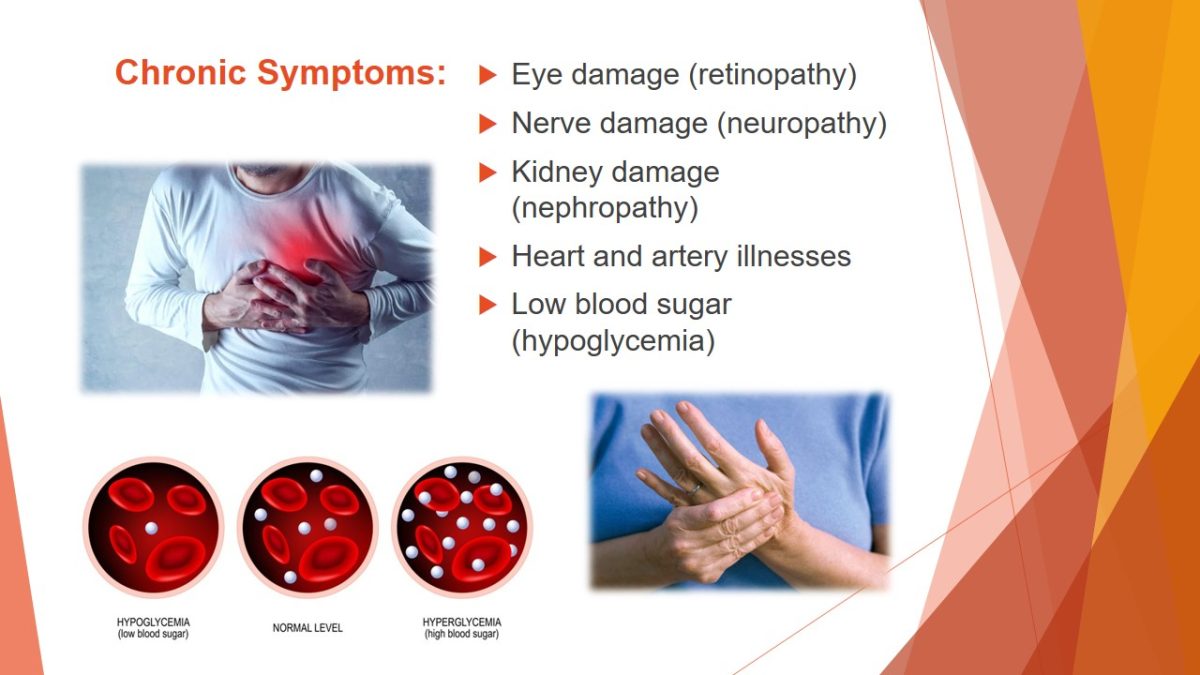
Tests Performed
Besides the apparent symptoms, type 1 diabetes mellitus can be diagnosed by performing blood sugar tests. Several initial tests help determine the severity of the illness:
- Fasting plasma glucose (FPG) test.
- Oral glucose tolerance test (OGTT).
- Random blood glucose test.
- Hemoglobin A1C (glycohemoglobin).
Besides the common symptoms, type 1 diabetes mellitus can be diagnosed by performing blood sugar tests. Several initial tests help determine the severity of the illness:
Fasting plasma glucose (FPG) test. In this case, the blood of the patient is taken upon the morning after fasting during night. Healthy people’s blood sugar levels vary between 70 and 100 mg/dL. However, diabetic people have their blood at 126 mg/dL or higher level.
Oral glucose tolerance test (OGTT). Two hours upon measuring the blood sugar level, a person must drink 75 grams of glucose. Diabetes is diagnosed if the 2-hour blood sugar level is 200 mg/dL or higher.
Random blood glucose test. Any time that a patient has blood sugar levels above 200 mg/dL alongside common diabetic symptoms, a person immediately gets diagnosed with T1DM.
Hemoglobin A1C (glycohemoglobin). With these tests, doctors and patients are able to measure their average glucose level over the prior two to three months. Diabetes is diagnosed if the hemoglobin A1C level is 6.5% percent or higher (Harvard Health Publishing, 2018).

Pertinent Lab Value
Patients who have fasting (more than 8 hours) blood glucose over 126 mg/dL or blood sugar excesses 200 mg/dL immediately get diagnose with Type 1 Diabetes.
For nondiabetic healthy people, the two-hour fasting blood glucose steadily stays in the range of 70-110 mg/dl. This is the average level of blood sugar, which varies slightly from one laboratory to another according to technical factors (McConnell, 2013 p. 394). Patients who have fasting (more than 8 hours) blood glucose over 126 mg/dL or blood sugar excesses 200 mg/dL immediately get diagnosed with Type 1 Diabetes.
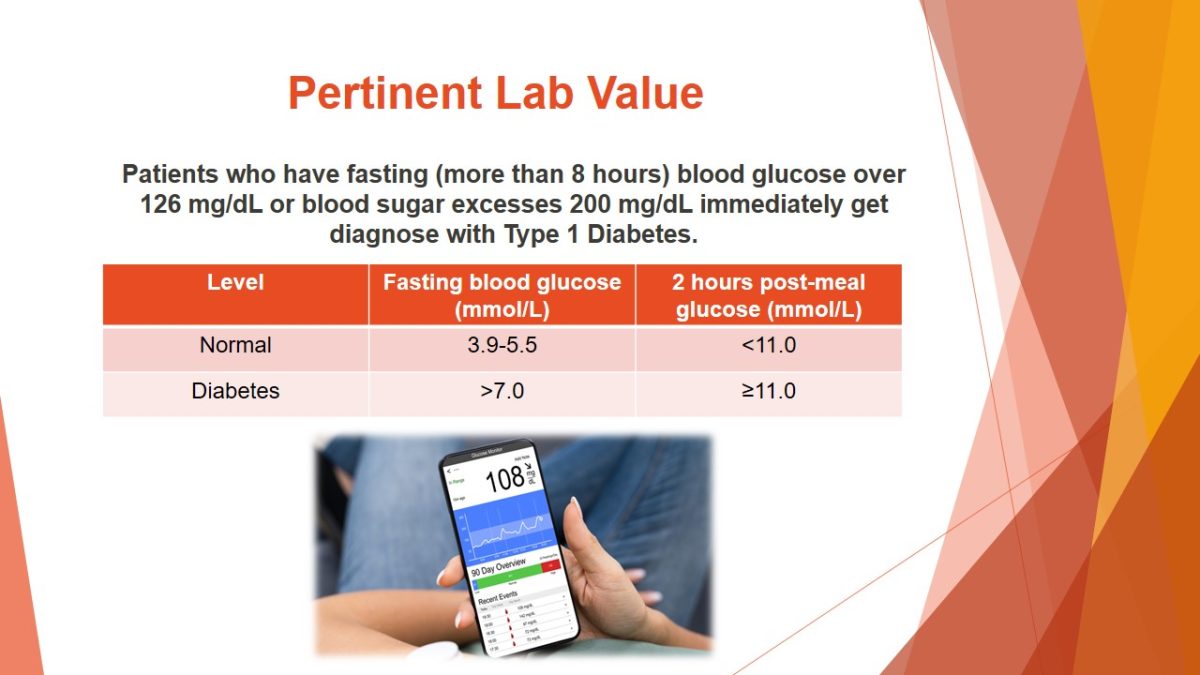
Treatments
- Daily insulin injections.
- Checking blood sugar levels all the time to regulate the intake of the medication.
- Exercising.
- Diet.
The standard treatment of type 1 diabetes is daily insulin injections. It balances the deficit of the insulin that the body is unable to produce. The daily dose of these injections for people with T1DM varies from two to four injections a day.
Besides the constant insulin intakes, patients must check their blood sugar levels all the time to regulate the intake of their medication. The specific blood tests are produced with the help of which a person has the ability to test their blood sugar within seconds at any time.
Another requirement for people with diabetes is regular exercise and strict diet because it keeps the amount of glucose in the blood relatively constant as well as protects the heart and the blood vessels (Harvard Health Publishing, 2018).

Prevention
Primary:
- Genetic susceptibility:
- Family history;
- Genetic Testing.
- Tests for any evidence of immune activation.
Secondary:
- The detection and treatment of pre-clinical pathological changes.
The prevention of T1DM divides into primary and secondary methods.
Primary prevention: specifically for type 1 diabetes, primary prevention is defined by genetic susceptibility, which is determined by family history or genetic testing. Moreover, the tests for any evidence of immune activation directed against the islets are also considered as primary prevention.
Secondary prevention: The detection and treatment of pre-clinical pathological changes lead to the prevention of severe type 1 diabetes progression after a person has been diagnosed. In T1D, the earlier confirmed marker of immune activation is the post autoantibody detection period.
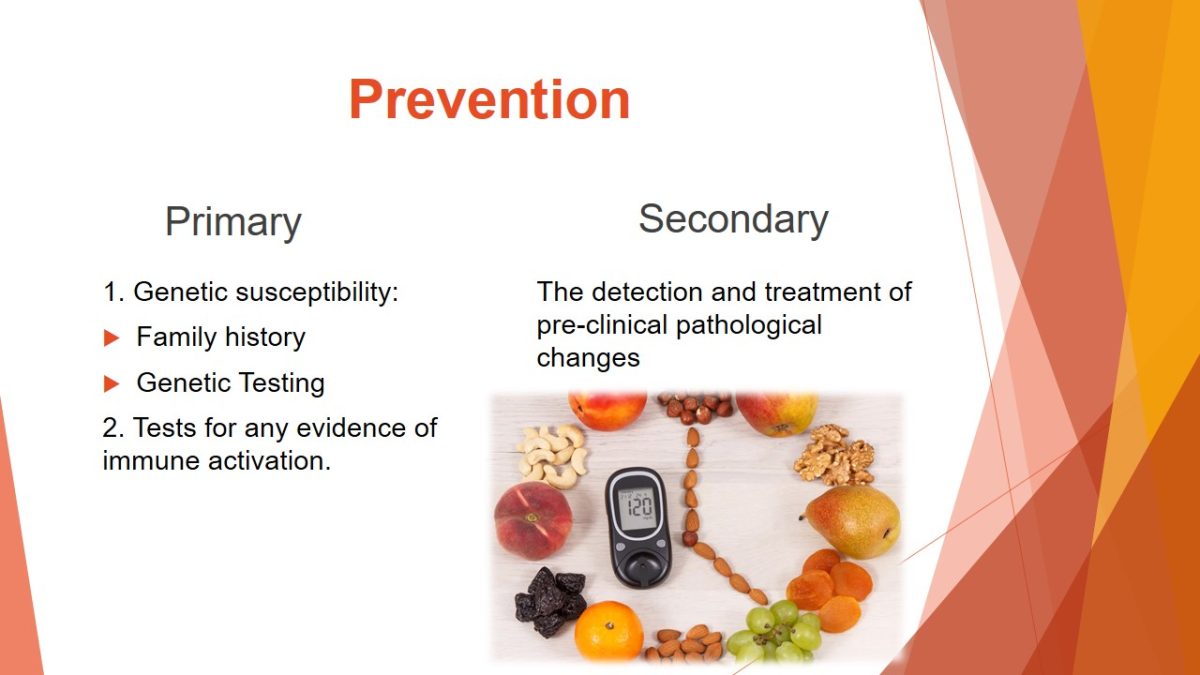
Prognosis
- Patient diagnose with type 1 diabetes must adjust to the continual strict treatment of the disease.
- Constant monitoring of the blood sugar levels is required to maintain a healthy level of life.
Poorly treated type 1 diabetes can result in fatal consequences; it can cause severe chronic symptoms.
A patient diagnosed with type 1 diabetes must adjust to the continual strict treatment of the disease. Constant monitoring of blood sugar levels is required to maintain a healthy level of life.
With constant, careful treatment, the risk of complications is substantial. However, it can be significantly reduced if you strictly monitor and control your blood glucose levels (Harvard Health Publishing, 2018).
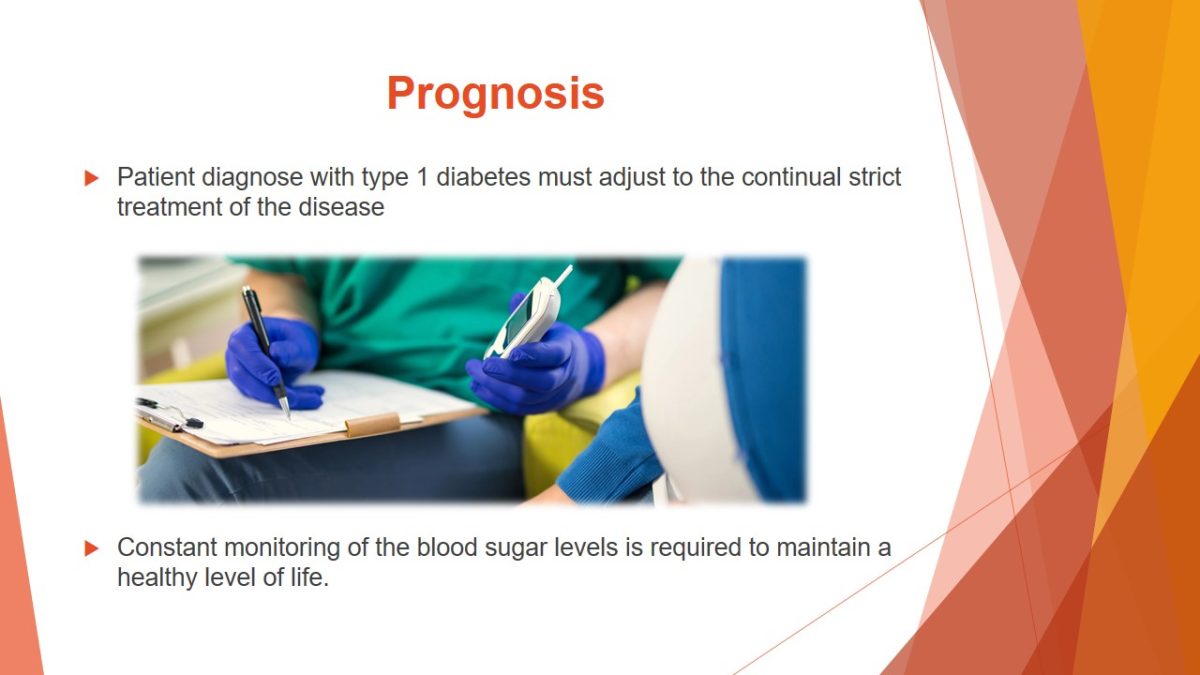
References
Harvard Health Publishing. (2018). Type 1 Diabetes Mellitus. Web.
Katsarou, A., Gudbjörnsdottir, S., Rawshani, A., Dabelea, D., Bonifacio, E., Anderson, B. J., … Lernmark, Å. (2017). Type 1 diabetes mellitus. Nature Reviews Disease Primers, 3(1). Web.
McConnell, T. H. (2013). The nature of disease: pathology for the health professions(2nd ed.). Burlington, MA: Jones & Bartlett Learning.